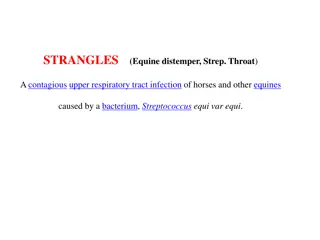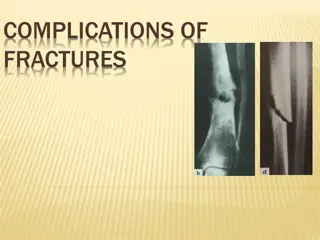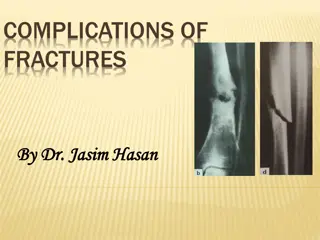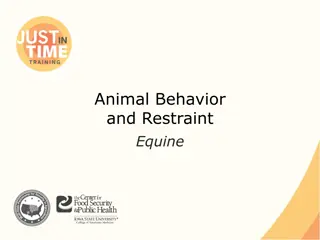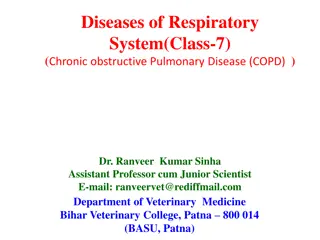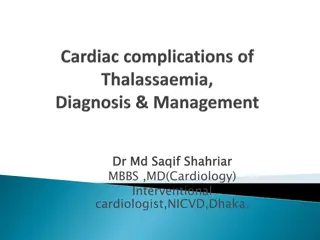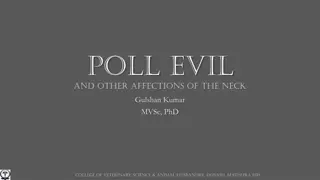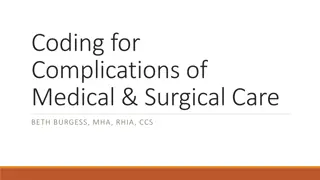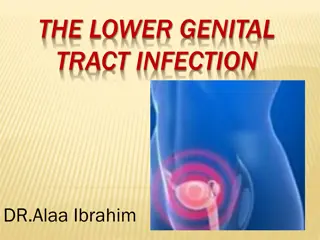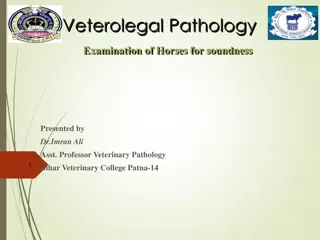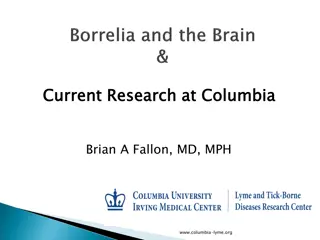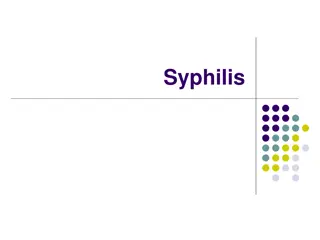Understanding Strangles in Horses: Symptoms, Treatment, and Complications
Strangles, also known as Equine Distemper, is an infectious disease affecting horses and equids. It is characterized by upper respiratory tract infection, lymph node abscesses, and various complications. Symptoms include nasal discharge, coughing, and swelling of lymph nodes. Prompt diagnosis and treatment are crucial to prevent fatal complications such as Bastard Strangles and Purpura Haemorrhagica. Understanding the epidemiology, transmission, and clinical signs of strangles is essential for effective management and prevention.
Download Presentation

Please find below an Image/Link to download the presentation.
The content on the website is provided AS IS for your information and personal use only. It may not be sold, licensed, or shared on other websites without obtaining consent from the author. Download presentation by click this link. If you encounter any issues during the download, it is possible that the publisher has removed the file from their server.
E N D
Presentation Transcript
Anil Kumar Asst. Professor Dept. of VCC UNIT-5
Strangles (Synonyms: Equine distemper) It is an acute infectious disease of horses and other equids, characterized by upper respiratory tract infection and abscess of lymph nodes of the throat region. Etiology Streptococcus equi, G+ve World wide and can affect any age group (Mostly 1-5 years of age) As a sequelae of haemorrhagica (allergic reaction to streptococcal antigen) or empyema of guttural pouches may occur strangles, purpura Epidemiology Direct or indirect contact. Direct contact recovered animals/carriers) Indirect contact (contaminated stable (buckets, feed, walls, doors) or pasture environment (grass, fences, but almost always the water troughs), or through flies. (Incubating strangles/just Transmission
Susceptible horses develop strangles within 3 to 14 days of exposure. Animals show typical signs of a generalized infectious process (depression, inappetence, fever of 39-39.5 0 c). More typically of strangles, horses develop a nasal discharge (initially mucoid, rapidly thickening to purulent), a soft cough, and slight but painful swelling between the mandibles along with swelling of the submandibular lymph node. Horses are often seen positioning their heads low and extended, so as to relieve the throat and lymph node pain. With the progression of the disease, abscesses develop in the submandibular (between the jawbones) and/or retropharyngeal (at the back of the throat) lymph nodes.
The lymph nodes become hard and very painful, and may obstruct breathing ( strangles ). The lymph node abscesses will burst (or can be lanced) in 7 to 14 days, releasing thick pus heavily contaminated with S. equi. The horse will usually rapidly recover once abscesses have ruptured. Although the disease process described above is classic. Some horses (especially older animals) develop a mild, short lasting disease without or with minor lymph node abscessation. This is thought to be the result of partial immunity although this may also result from infection by S.equi of relatively low virulence. Classic strangles is a severe infection that can be fatal, usually as a result of a variety of complications that occur.
The main and often fatal complications of strangles are: 1. Bastard strangles(Metastatic strangles) 2. Purpura haemorrhagica 1. Bastard strangles (Metastatic strangles): Which describes the dissemination of infection to unusual sites other than the lymph nodes draining the throat. For example, abdominal or lung lymph nodes may develop abscesses and rupture, sometimes weeks or longer after the infection seems to have resolved. A brain abscess may rupture causing sudden death or a retropharyngeal lymph node abscess may burst in the throat and the pus will be inhaled into the lung. 2.Purpura haemorrhagica: Which is an immune-mediated acute inflammation of peripheral blood vessels that occurs within four weeks of strangles, while the animal is convalescing. It results from the formation of immune complexes between the horse s antibodies and bacterial components. These immune complexes become trapped in capillaries where they cause inflammation, visible in the mucous membranes as pinpoint haemorrhages. These haemorrhages lead to a widespread severe edema of the head, limbs, and other parts of the body.
RUPTERED LYMPH NODES SWELLNG OF PHARYNGEAL LYMPH NODES
Minor, non-fatal complications include: 1. Post strangles myocarditis (inflammation of heart muscle), which may follow strangles in a small proportion of horses. 2. Purulent cellulitis (inflammation of the subcutaneous tissue), which is an unusual occurrence where infection spreads locally in the subcutaneous tissue to the head. 3. Laryngeal hemiplegia, which involves paralysis of the throat muscles. It is commonly referred to as roaring. The condition may follow abscessation of cervical lymph nodes. 4. Anaemia (low red blood cell count), during the convalescent period as a result of immune mediated lysis of red blood cells. 5. Guttural pouch empyaema (filled with pus):Persistent infection in the guttural pouch may lead to inspissation (drying) of pus and, in some cases, the formation of a solid, stone-like, concretion called chondroid. Animals that have persistent infection of the guttural pouches become the carriers, the major source of infection to spark outbreaks in susceptible horses
Diagnosis Diagnosis is confirmed by bacterial culture of exudate from abscesses or nasal swab samples. CBC reveals neutrophilic leukocytosis and hyper fibrinogenemia. Serum biochemical analysis is typically unremarkable. Complicated cases may require endoscopic examination of the upper respiratory tract (including the guttural pouches), ultrasonographic examination of the retropharyngeal area, or radiographic examination of the skull to identify the location and extent of retropharyngeal abscesses. Treatment The environment for clinically ill horses should be warm, dry, and dust-free. Warm compresses are applied to sites of lymphadenopathy to facilitate maturation of abscesses. Facilitated drainage of mature abscesses will speed recovery. Ruptured abscesses should be flushed with dilute (3% 5%) povidone-iodine solution for several days until discharge ceases
NSAIDs can be administered judiciously to reduce pain and fever and to improve appetite in horses with fulminant clinical disease. Tracheotomy may be required in horses with retropharyngeal abscessation and pharyngeal compression. Antibiotic therapy is indicated in cases with dyspnea, dysphagia, prolonged high fever, and severe lethargy/anorexia. Administration of penicillin @ 22,000 IU/kg, IM, bid for 3-5 days during the early stage of infection ( 24 hr of onset of fever) will usually abort abscess formation. Prevention and Control Good hygienic measures Isolation of animal and their treatment Vaccination of healthy one with killed streptococcal vaccine (contain 4 different types of streptococci) @ 10 ml SC may be recommonded.


